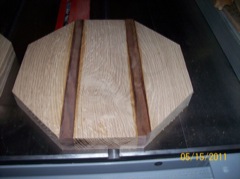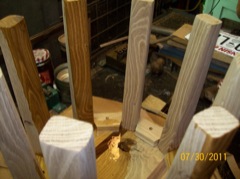Eight-legged Stools
Every one has a story.
Stool #8: Lighter build and somewhat smaller in white oak and walnut. Heavily charactered wood top and legs (knotty & quarter sawn). Black Cherry leg braces.
"To practice any art, no matter how well or badly, is a way to make your soul grow. So do it!"; Kurt Vonnegut.
I like the character of this wood. Some might say; "Why do you choose such crappy wood to build these stools." I would reply to the contrary. These knots and such show the character of the tree the wood came from. These are the parts of the tree where all the action happens. It makes branches to spread itself out to collect light it requires in order to grow and survive. The tree changes the density of the wood around the branch. There are chemical changes that change the color of the wood and when you cut the wood in quarter sawing you show the lateral rays that transport water and nutrients sideways in the tree.
By the time you get the straight grain the tree is old and boring - just resting on it's laurels and building it's personal wealth <yawn>.
So, you might ask, if this wood was chosen for it's high character then why not let it stand on it's own. Why add the walnut, which actually seems to distract from the flow of the pattern in the Oak?
I agree, but once again I am limited by the design of the stool which requires 13 inches of width. The Oak board was barely 4 inches wide - which only gave me 12 inches. And as you can see from this picture, the patterns don't match up very well when put next to each other (this is not a butterfly cut) ...
... so the walnut breaks things up just enough for the eye to be satisfied.
The part of making these stools -- or any woodworking in natural wood -- that is the most fun for me is the application of the first coat of finish (polyurethane in this case). The color and character of the wood turns on, like a lightbulb, with every stroke of the brush. It's like those coloring books for kids where you just rub across the drawing and it fills in the colors. This step is the payoff for all time it takes to make those multiple passes with the different grades of sandpaper.
I am just finishing this stool (July 2011) - along with stool #9 - and will have more pictures as they become available.



